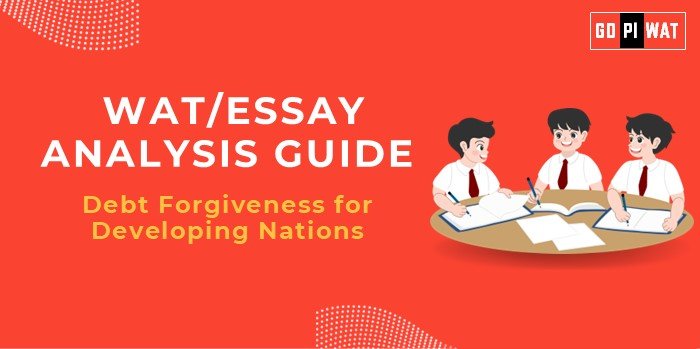📋 WAT/Essay Analysis Guide
💰 Debt Forgiveness for Developing Nations
🌟 Understanding the Topic’s Importance
Debt forgiveness for developing nations reflects the broader themes of economic justice, fiscal responsibility, and international relations. B-school candidates should grasp both macroeconomic policies and their social implications, showcasing their ability to link financial frameworks with global equity concerns.
📝 Effective Planning and Writing
- ⏱️ Time Allocation:
- Plan: 5 minutes
- Write: 20 minutes
- Review: 5 minutes
- 💡 Preparation Tips:
- Collect key statistics on debt levels and relief impacts.
- Outline potential stakeholders’ perspectives, including creditors, international organizations, and recipient nations.
- Consider comparative case studies, such as Zambia, Greece, or Ghana, to highlight varied outcomes.
💡 Introduction Techniques
-
- Contrast Approach:
“While developing nations accrue crippling debt, crises exacerbate their struggles, raising pressing questions about global responsibility in debt forgiveness.”
-
- Timeline Approach:
“From early relief programs in the 1990s to today’s G20 DSSI, debt forgiveness has evolved in response to crises.”
-
- Case-Based Start:
“Zambia’s debt struggles illustrate the perils and potential of forgiveness mechanisms.”
🔍 Structuring the Essay Body
🏆 Achievements:
- 🌍 Historical Successes: Initiatives like the HIPC (Heavily Indebted Poor Countries) program helped nations like Uganda invest in healthcare and education.
- 📈 Developmental Impact: Debt relief programs have enabled critical infrastructure projects, improving quality of life and economic opportunities.
⚠️ Challenges with Comparative Analysis:
- 💰 Risk of Moral Hazard: Forgiveness may encourage unsustainable borrowing if not paired with accountability measures.
- 📉 Mixed Results: Nations like Greece faced prolonged economic challenges despite restructuring efforts.
- 🌐 Global Disparities: Wealthier nations often dictate terms, limiting the autonomy of developing countries.
🔮 Future Outlook:
- 📜 Conditional Frameworks: Tie debt forgiveness to reforms in governance, transparency, and fiscal discipline.
- 🤝 Sustainable Development Paths: Focus relief on investments in renewable energy, education, and healthcare.
- 🌍 Global Partnerships: Collaborate with international institutions like the IMF to create equitable policies tailored to individual nations’ needs.
📄 Concluding Effectively
-
- Balanced Conclusion:
“Debt forgiveness remains a vital tool during crises but must align with structural reforms to ensure sustainable economic development.”
-
- Global Comparison Conclusion:
“The mixed results from past initiatives emphasize the need for comprehensive approaches combining relief with reform.”
📝 Sample Short Essays (100 Words Each)
📌 Balanced Perspective:
“Debt forgiveness during crises offers temporary fiscal relief, enabling crucial development investments. However, without structural reforms and strict conditionalities, such measures risk creating a cycle of dependency and fiscal irresponsibility. Past initiatives, like the HIPC, show mixed results, underlining the need for new frameworks to ensure accountability and sustained growth.”
📌 Solution-Oriented:
“Developing nations’ debt burdens undermine health and economic security during crises. Forgiveness programs should be designed with conditional reforms focused on infrastructure, social investments, and transparent governance. Debt relief offers a unique chance to catalyze growth and stabilize economies, provided mechanisms guard against future over-borrowing.”
📌 Global Comparison:
“While Greece’s austerity-heavy debt restructuring contrasts sharply with Ghana’s temporary growth post-relief, the global debate on debt forgiveness highlights varied results. Successful models emphasize balanced interventions: immediate relief paired with long-term reforms to promote sustainable, equitable growth.”


